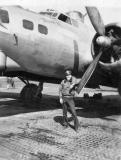|
|
#1 |
|
Member
Join Date: Jul 2021
Posts: 77
|
well I finally got the correct brake master cylinder on my model t. The problem is when I added brake fluid I opened the bleeder screws and got no brake fluid dripping after two days. The model t has been sitting for 30 years so the rubber lines maybe clogged. So my options are to bleed the brakes and or replace the rubber flex hoses. The other question is could the brake bleeders be clogged. What do you all think?
Thanks Jerry |
|
|

|
|
|
#2 |
|
Senior Member
Join Date: Jun 2010
Location: San Antonio, Texas
Posts: 16,449
|
Any part of the fluid circuit could be clogged. Even synthetic rubber deteriorates. Metal fluid lines can get clogged from the hardening of very old fluid. A person would have to replace any rubber line after so many years of inactivity. Blow air through any metal lines to check for clog. Replace any that need it. A corroded metal line will blow out if the wall of the tube gets too thin.
|
|
|

|
| Sponsored Links (Register now to hide all advertisements) |
|
|
|
|
#3 |
|
Senior Member
Join Date: Jul 2010
Location: Pennsylvania
Posts: 1,104
|
Bleeding the brakes is a two man job (unless you have a vacuum or pressure bleeder). Someone has to work the brake pedal, and someone has to man the bleeder. Air bubbles in the system can prevent gravity bleeding like you seem to be attempting. The process is: pump the pedal a few times while the bleeder is closed. On the last pump, hold the pressure on the pedal. With pressure on the pedal, the other guy opens the bleeder. The pedal will sink to the floorboard. When it does, have the guy working the pedal tell you so while keeping pressure on the pedal. Close the bleeder. Repeat the pump, hold, bleed, close process over and over until all the air bubbles are expelled. Start at the wheel furthest from the master cylinder, and work your way to the one closest. Keep an eye on the level of the fluid in the master cylinder and refill multiple times while repeating the process.
|
|
|

|
|
|
#4 |
|
Member
Join Date: Jul 2021
Posts: 77
|
I agree with all of the suggestions. I think I will try bleeding the brakes first to see if fluid goes to the wheels. I agree rubber hoses would be the first culprit. Then hard lines. All ways something to do.
Thanks Jerry |
|
|

|
|
|
#5 |
|
Member
Join Date: Jul 2021
Posts: 77
|
I had my kid step on the brake pedal and I spun the drum brakes on each corner. The rear slowed down a little but the fronts just spun. I am going to unbolt the feed line to the proportioning valve to see if there is fluid going from the master. Then I’m going to take off rubber hoses that brake wheel cylinder. I’m betting bad hose.
Thanks Jerry |
|
|

|
|
|
#6 |
|
Member
Join Date: Jul 2021
Posts: 77
|
Sponsored Links (Register now to hide all advertisements)
Thanks Jerry |
|
|

|
|
|
#7 |
|
Senior Member
Join Date: Jul 2010
Location: Pennsylvania
Posts: 1,104
|
It's possible. The wheel cylinders might be clogged with rust and gunk.
|
|
|

|
|
|
#8 |
|
Member
Join Date: Jul 2021
Posts: 77
|
I saw this guy push on the brake shoes to see if the wheel cylinder move. I will try this on the front.
Thanks Jerry |
|
|

|
|
|
#9 |
|
Member
Join Date: Jul 2021
Posts: 77
|
ok I tried pushing the drum brake shoes into the wheel cylinder. No movement at all when I pushed the brakes. I also started getting fluid out of the passenger side hose and a dribble out of the bolts on the driver side. Almost like pressure was stuck at the wheel cylinder. Im going to change the cylinders this week. Hope it works
Thanks Jerry |
|
|

|
|
|
#10 |
|
Member
Join Date: Jul 2021
Posts: 77
|
Ok I took wheel cylinder out of drum brakes. I had a little fluid coming out the hydraulic line. So I started cleaning out stuff. I took bleeder screw and blew it out with air. Next I have fluid to rubber hose so I took a thin wire and tried pushing it thru the rubber hose. After all this I started getting a little fluid to the wheel cylinder. My other major concern is the area where rubber line goes to metal line is inaccessible.
Thanks Jerry |
|
|

|
 |
«
Previous Thread
|
Next Thread
»
|
|
| Sponsored Links (Register now to hide all advertisements) |
|
|
All times are GMT -5. The time now is 10:20 AM.





 Linear Mode
Linear Mode

